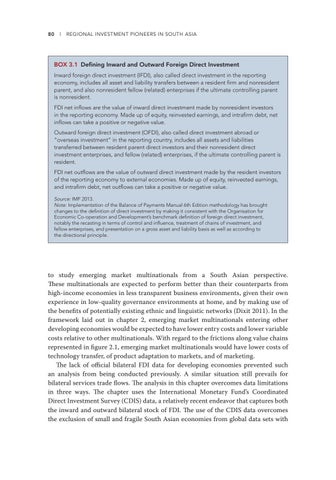80 l REGIONAL INVESTMENT PIONEERS IN SOUTH ASIA
BOX 3.1 Defining Inward and Outward Foreign Direct Investment Inward foreign direct investment (IFDI), also called direct investment in the reporting economy, includes all asset and liability transfers between a resident firm and nonresident parent, and also nonresident fellow (related) enterprises if the ultimate controlling parent is nonresident. FDI net inflows are the value of inward direct investment made by nonresident investors in the reporting economy. Made up of equity, reinvested earnings, and intrafirm debt, net inflows can take a positive or negative value. Outward foreign direct investment (OFDI), also called direct investment abroad or “overseas investment” in the reporting country, includes all assets and liabilities transferred between resident parent direct investors and their nonresident direct investment enterprises, and fellow (related) enterprises, if the ultimate controlling parent is resident. FDI net outflows are the value of outward direct investment made by the resident investors of the reporting economy to external economies. Made up of equity, reinvested earnings, and intrafirm debt, net outflows can take a positive or negative value. Source: IMF 2013. Note: Implementation of the Balance of Payments Manual 6th Edition methodology has brought changes to the definition of direct investment by making it consistent with the Organisation for Economic Co-operation and Development’s benchmark definition of foreign direct investment, notably the recasting in terms of control and influence, treatment of chains of investment, and fellow enterprises, and presentation on a gross asset and liability basis as well as according to the directional principle.
to study emerging market multinationals from a South Asian perspective. These multinationals are expected to perform better than their counterparts from high-income economies in less transparent business environments, given their own experience in low-quality governance environments at home, and by making use of the benefits of potentially existing ethnic and linguistic networks (Dixit 2011). In the framework laid out in chapter 2, emerging market multinationals entering other developing economies would be expected to have lower entry costs and lower variable costs relative to other multinationals. With regard to the frictions along value chains represented in figure 2.1, emerging market multinationals would have lower costs of technology transfer, of product adaptation to markets, and of marketing. The lack of official bilateral FDI data for developing economies prevented such an analysis from being conducted previously. A similar situation still prevails for bilateral services trade flows. The analysis in this chapter overcomes data limitations in three ways. The chapter uses the International Monetary Fund’s Coordinated Direct Investment Survey (CDIS) data, a relatively recent endeavor that captures both the inward and outward bilateral stock of FDI. The use of the CDIS data overcomes the exclusion of small and fragile South Asian economies from global data sets with

